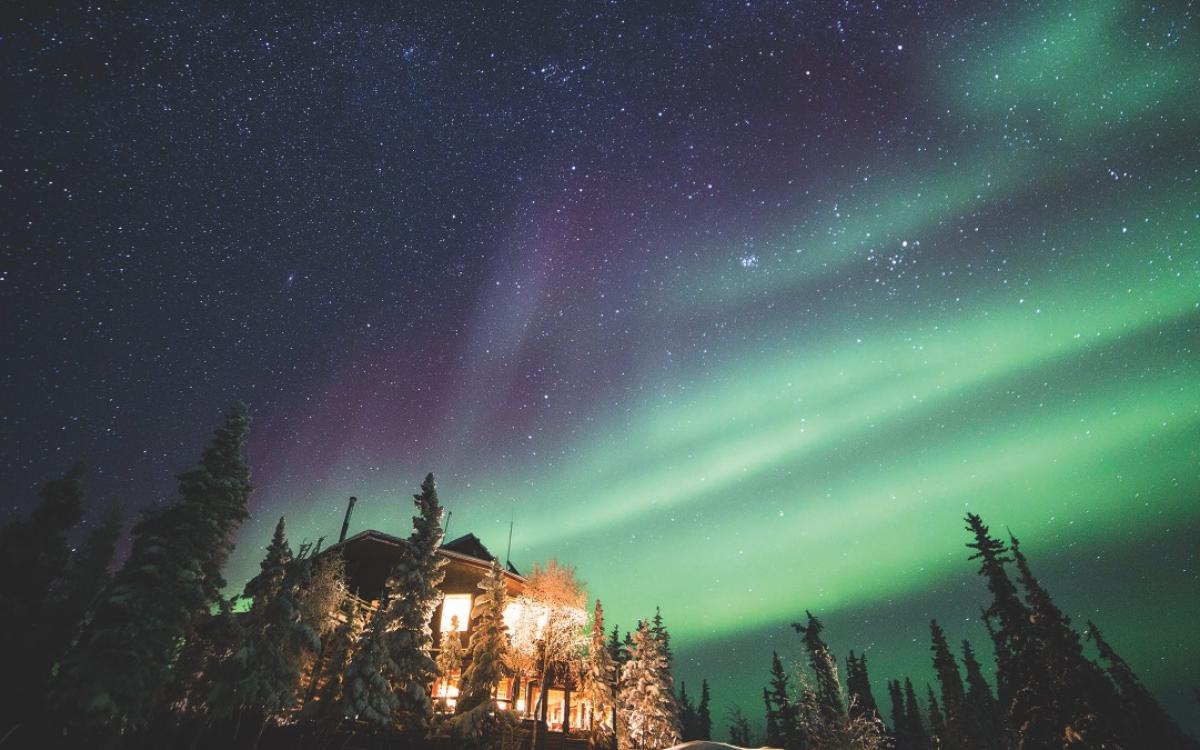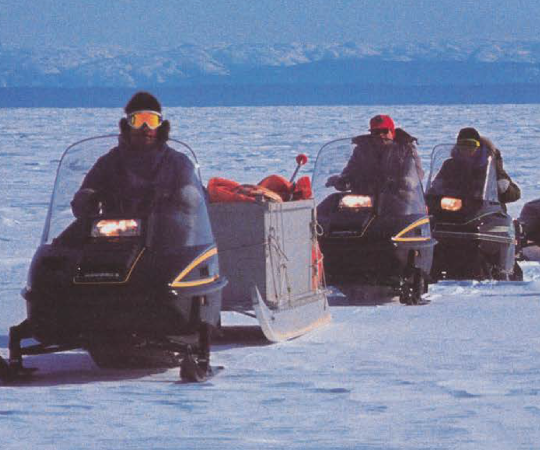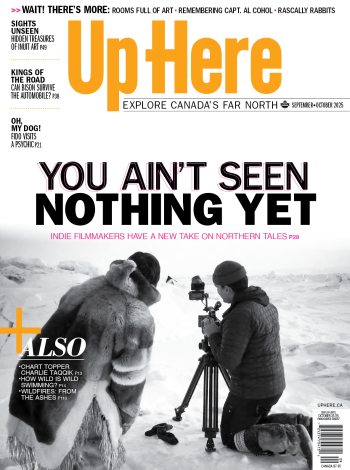Northerners are a travelling bunch. So when you ask them where they’d choose to go in their home territory, they are not short of adventuresome ideas. We asked 30 northern residents where they would go for a “staycation” during this stay-at-home summer. Their preferences range from rugged to relaxed, all destinations with lots of sky, some wildlife and often, some unusual history. All are highly recommended for visiting by people who actually live here.

NORTHWEST TERRITORIES
Drive to Tuktoyaktuk
The road to Tuktoyaktuk has several fans. “I want to be able to say I have driven Canada from coast to coast to coast,” says one Northerner. This unique highway connects Tuktoyaktuk on the Arctic Coast with Inuvik, a regional centre and the termination of the Dempster Highway, which, in turn, links with southern Canada. The 140-kilometre Tuk road winds across pingo-dotted tundra to Tuktoyaktuk’s welcoming beaches. Admire the logs that travelled a thousand kilometres on the Mackenzie River and “dip a toe in the Arctic Ocean.”
Blachford Lake Lodge
Easily accessible by way of a short (and fun) float-plane ride from Yellowknife in summer or winter, the Blachford lodge combines unique design and the latest in eco-friendly technology. There’s wireless internet, a hot tub with view, a sauna and in season, a friendly aurora wake-up service. Guests have fond memories of short hikes and picnics on the lake, followed by delicious gourmet meals, and a visit with a Dene host in a tipi. “A surprising mix of rugged luxury.”
Peterson’s Point Lake Lodge
For spectacular fall photography, wildlife viewing, aurora watching and berry picking, several NWT residents chose Peterson’s, a fly-in lodge some 320 kilometres north of Yellowknife, close to the Arctic Circle. It’s the perfect place to explore the vast beauty of the North, claims a keen photographer. “The tree-less hilly landscape was painted in autumn shades of red, brown, copper, orange, yellow. Low-bush cranberries were plentiful, and the air was so clean and fresh!”

Virgina Falls /Nahanni National Park Reserve
Flightseeing is one of the best ways to first experience the Nahanni National Park Reserve’s diverse landscape. Tours from Fort Simpson stop at Nailicho (Virginia Falls) where Parks Canada interpreters greet visitors and lead them in a Dene ceremony. Some choose an overnight trip with a stay at Little Doctor Lake, close to the park, where a private lake and a beach all your own offer scenery and serenity. Or choose a multi-week Nahanni paddling expedition to explore the park more fully.
Thaidene Nene National Park Reserve
For a long, relaxed boat holiday, NWT residents recommend Thaidene Nene, Canada’s newest national park reserve. Encompassing a major portion of the attractions in the East Arm of Great Slave Lake, and managed by the Łutselk’e Dene, Thaidene Nene offers spectacular bird and wildlife viewing, “unique and epic rock scapes, breathtaking midnight-sun lit scenery, perfect camping conditions and, of course, the fishing. Oh, the fishing!”
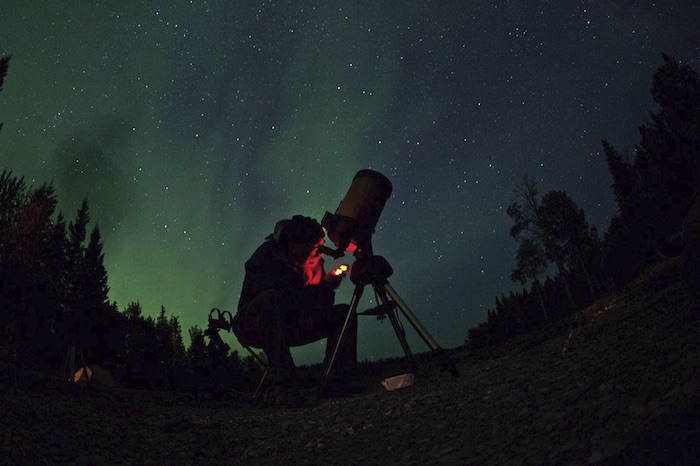
Dark Sky Festival Wood Buffalo National Park
Here’s another multi-resident staycation recommendation: the Dark Sky Festival at Wood Buffalo National Park. Canada’s largest park is the site of Canada’s largest dark sky preserve, where visitors can camp, join science activities and observe the dark night sky in late summer. Day trips invite close-up encounters with the park’s signature buffalo, barefoot romps on the amazing salt plains, and views of pelican families in the Slave River rapids at the town of Fort Smith, nearby.
Inuvik’s Mackenzie Delta Boat Tour
Northerners visit Inuvik in mid-summer for family-friendly festivals and activities. With the sun up 24 hours a day there’s plenty of time to sightsee. One memorable attraction is a boat tour on the magical Mackenzie Delta. “So many eagles in trees, flying—it is mystical, amazing.” In late summer, ducks and geese congregate while preparing for their flight south. Around each bend in the winding waterways your boat might startle swans that rise suddenly and gracefully and soar away overhead.

YUKON
Dawson City
Choose Dawson City for food and drink, says one Yukon resident. “You can camp, hike, play on the river, enjoy great restaurants in town, explore the history of the community and enjoy some of the best views in Yukon.” The views from the Dome are certainly legendary, and the Gold Rush history is intriguing. A National Historic Site and the Yukon’s original capital, Dawson City hosts several arts and music festivals each year where the fun never stops. Don’t miss Diamond Tooth Gerties!
Ogilvie Mountains, Kluane National Park
Yukon residents have plenty of stunning scenery in their backyard. To see it best, some suggest taking to the air. From Whitehorse, you can soar over the Ogilvie Mountains in a helicopter. Fall colours highlight beautiful rolling hills threaded by the Dempster Highway. As an alternative, take to the air from Haines Junction—park headquarters—to fly over Kluane National Park. Cruise for what seems like hours over the world’s largest non-polar icefields and snap a photo of Mount Logan, Canada’s highest peak (6,000 metres).
Atlin, British Columbia
Located on 136-kilometer long, glacier-fed Atlin Lake, Atlin is an irresistible draw for Yukon residents, just two or three hours south of Whitehorse. Perhaps the fact that there’s just the one road in, from the Yukon, is part of the appeal. Or it could be the friendly little community, with picturesque Gold Rush history. Or the mountains. Or the lake itself. The Taku River Tlingit are at home here. The annual Atlin Arts and Music Festival draws hundreds of campers and folkies for a mid-summer blow-out each year.
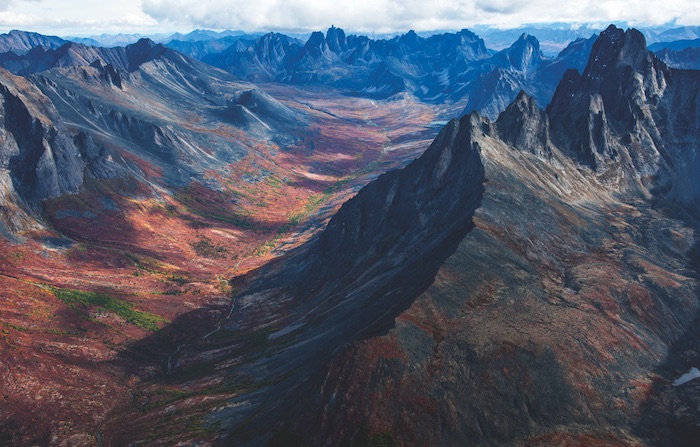
Tombstone Territorial Park
Hiking enthusiasts swear by Tombstone’s scenic trails. This Ogilvie Mountains park is called Ddhäl Ch’è Cha Nän—‘ragged mountain land’—and is part of the Tr’ondëk Hwëch’in land claim. Located on the Dempster Highway, 110 kilometres north of Dawson City, Tombstone is a remote wilderness area, 2,200 square kilometres of peaks, tundra and rivers, that offers camping, hiking and wildlife viewing. A much-photographed feature is Tombstone Mountain situated at the end of a scenic valley. Caribou, bears, Dall sheep and raptors roam freely here.
The Firth River, Ivvavik National Park
A Yukon resident proposes: “I’d head up to raft the Firth River with my family and hope to catch some views of the Porcupine Caribou herd before their numbers are decimated by drilling in Alaska.” Ivvavik means ‘a place for giving birth, a nursery,’ in the Inuvialuit language. The Firth River is one feature of this far northern park, with rapids, canyons, and ample hiking opportunities. In early summer, caribou migrate in this protected portion of the Porcupine Caribou calving grounds.
Boreale Ranch, Whitehorse
For a totally Yukon-style retreat, one respondent would head to Boreale Ranch, between Whitehorse and Carcross. A year-round adventure lodge set in the Yukon wilds, it is just 30 minutes from the city. There’s a main lodge with cozy library and huge windows for mountain gazing. In summer, stay in a fully equipped yurt. Day hikes, mountain biking, dog sledding or cross-country skiing are offered, with daily recharging in the outdoor mountain-facing spa tub.

NUNAVUT
Auyuittuq National Park
“Akshayuk Pass. Like so many dream vacations, if not now, when?” writes one northern resident. One of the most famous and scenic hiking routes in Nunavut, Akshayuk is a natural 97-kilometre corridor through a wild mountain range on eastern Baffin Island. The eight-to-nine day hike is anchored at one end by Pangnirtung and at the other by Qikiktarjuaq on Davis Strait. The trail’s wide valley is surrounded by dramatic snow-capped peaks draining into heath tundra, glacial moraines, and several waist-deep, fast-flowing, icy rivers.
Dundas Harbour, Northwest Passage Cruise
Among the more accessible stops on a Northwest Passage cruise, Dundas Harbour, at the eastern end of Lancaster Sound on Devon Island, rates highly with Nunavut guides. The site has Thule houses and structures, Arctic vegetation, superb scenery, and the remains of an old RCMP post. “There’s a wonderful sense of peace and history here, but never enough time to take it all in.” Birders might spot a nesting gyrfalcon on the cliffs, or red-throated loons and long-tailed ducks by the shore.

Sylvia Grinnell Territorial Park, Iqaluit
A long-time Iqaluit resident chose Sylvia Grinnell Territorial Park. “The hiking is so scenic and the nature is breathtaking. Listen to the river water running, spot birds, bugs and flowers. Hikers can even spot caribou.” Just one kilometre from the city, the park landscape is typical of the Arctic environment. This is a favorite local picnic and camping area with hills and valleys, a waterfall, tidal area and water views. Some 40 species of birds can be spotted here, amid a tundra and bedrock landscape.
Bathurst Inlet
Anyone who has ever been there, longs to go back. “The place is so peaceful and beautiful, surrounded by blue water and green landscape,” says one Nunavut resident. For vigorous exercise, another chose the Window Falls hike. “It’s a beautiful hike, awesome wildflowers, muskox, caribou, swans, Thule and pre-Inuit sites, nesting peregrines, golden eagles, incredible views over Bathurst Inlet and the Tinney Hills, Franklin history. And, several unbelievable waterfalls!”
Narwhal migration, Pond Inlet
“The floe edge at Pond Inlet is literally the line of life,” says a well-travelled resident. Each spring, the open water by the floe edge attracts sea mammals migrating north, among them, narwhal, the unicorns of the sea. Outfitters offer day- and week-long camping trips to view mammal and bird migrations from camps on slowly melting sea ice. In late spring, the sun never sets. Inuit guides drive visitors from the community of Pond Inlet to the floe edge by snowmachine and sled.


